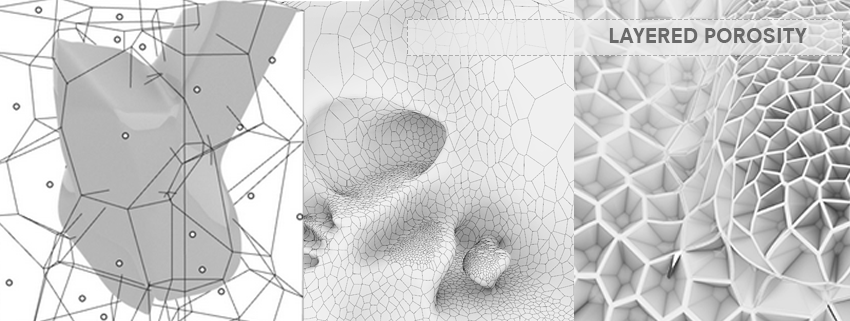Shared:FinalG2
Anjes Swart - Bart Bonenkamp - Dries Brøns - Emma Chris Avrămiea - Sander van Rosmalen - Yanchen Wang
Layered Porosity
Slide 1: The concept we have explored is that of layered porosity, Layered not in the traditional sense, but a tridimensional one. The concept of porosity refers to the materiality, the logic of the construction Slide 2-4: Concept. The computational logic as well as the architectural function of the design will be explored. Slide 5-6: The concept is based on the exploration of the Voronoi, a mathematical way of reconfiguring geometries based on a point cloud. Slide 7: The Voronoi logic is applied at the large scale of the whole habitat. Slide 8: And can be controlled to create spaces of different sizes, based on the needs of the astronauts (such as a space for a dry lab or a sleeping area. Slide 9: The system is componential, such that it can be expanded. The main advantages of applying this logic are economy of energy and of materials. Instead of building separate habitats, if these are able to share a wall, a rover excavating the same path, considerable amounts of energy would be saved. Slide 10: From the large scale we zoom into the componential scale and study a fragment of this habitat. Slide 11-12: On which we performed a structural analysis, to understand roughly the tensile and compressive forces at stake. Slide 13: The respective stress lines are used to inform a point cloud, which is the basis of the Voronoi structure. In this way, the density of the cells (and thus the structural stability), increases in proportion to increasing loads. In other words, the Voronoi cells are structurally optimized. Thus material is 3d printed and distributed only where needed (efficient material distribution). Slide 14: The point cloud is also informed by the functionality of the space, in the case of the chosen fragment, a space appropriate for sleeping and socializing as well as performing light work. Slide 15-16 A section through the habitat and a few local examples of how the points density creates different patterns with specific functions (storing). In terms of human comfort, the horizontal surfaces have a higher cell density (surfaces to walk, lie, sit on or sleep on). Slide 17-20: A detailed look at how the inhabitants use the space. Slide 21-23: in terms of robotic production, we have tested the excavation through a milling procedure. EPS has been used as an analogue of Martian soil, and the simulation was meant to test the milling toolpaths.
